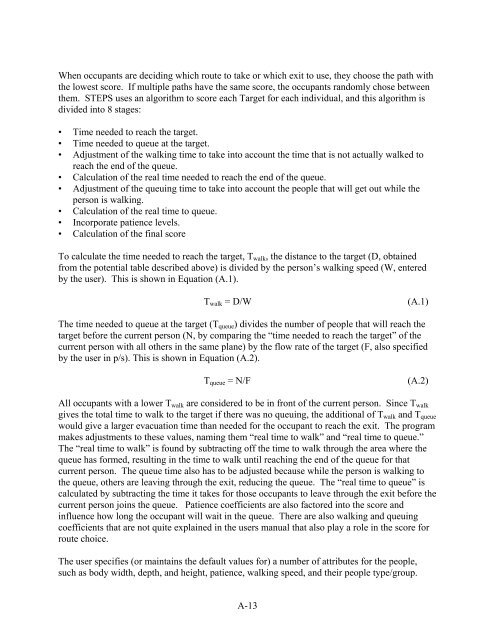A Review of Building Evacuation Models - NIST Virtual Library
A Review of Building Evacuation Models - NIST Virtual Library
A Review of Building Evacuation Models - NIST Virtual Library
You also want an ePaper? Increase the reach of your titles
YUMPU automatically turns print PDFs into web optimized ePapers that Google loves.
When occupants are deciding which route to take or which exit to use, they choose the path with<br />
the lowest score. If multiple paths have the same score, the occupants randomly chose between<br />
them. STEPS uses an algorithm to score each Target for each individual, and this algorithm is<br />
divided into 8 stages:<br />
• Time needed to reach the target.<br />
• Time needed to queue at the target.<br />
• Adjustment <strong>of</strong> the walking time to take into account the time that is not actually walked to<br />
reach the end <strong>of</strong> the queue.<br />
• Calculation <strong>of</strong> the real time needed to reach the end <strong>of</strong> the queue.<br />
• Adjustment <strong>of</strong> the queuing time to take into account the people that will get out while the<br />
person is walking.<br />
• Calculation <strong>of</strong> the real time to queue.<br />
• Incorporate patience levels.<br />
• Calculation <strong>of</strong> the final score<br />
To calculate the time needed to reach the target, T walk , the distance to the target (D, obtained<br />
from the potential table described above) is divided by the person’s walking speed (W, entered<br />
by the user). This is shown in Equation (A.1).<br />
T walk = D/W<br />
(A.1)<br />
The time needed to queue at the target (T queue ) divides the number <strong>of</strong> people that will reach the<br />
target before the current person (N, by comparing the “time needed to reach the target” <strong>of</strong> the<br />
current person with all others in the same plane) by the flow rate <strong>of</strong> the target (F, also specified<br />
by the user in p/s). This is shown in Equation (A.2).<br />
T queue = N/F<br />
(A.2)<br />
All occupants with a lower T walk are considered to be in front <strong>of</strong> the current person. Since T walk<br />
gives the total time to walk to the target if there was no queuing, the additional <strong>of</strong> T walk and T queue<br />
would give a larger evacuation time than needed for the occupant to reach the exit. The program<br />
makes adjustments to these values, naming them “real time to walk” and “real time to queue.”<br />
The “real time to walk” is found by subtracting <strong>of</strong>f the time to walk through the area where the<br />
queue has formed, resulting in the time to walk until reaching the end <strong>of</strong> the queue for that<br />
current person. The queue time also has to be adjusted because while the person is walking to<br />
the queue, others are leaving through the exit, reducing the queue. The “real time to queue” is<br />
calculated by subtracting the time it takes for those occupants to leave through the exit before the<br />
current person joins the queue. Patience coefficients are also factored into the score and<br />
influence how long the occupant will wait in the queue. There are also walking and queuing<br />
coefficients that are not quite explained in the users manual that also play a role in the score for<br />
route choice.<br />
The user specifies (or maintains the default values for) a number <strong>of</strong> attributes for the people,<br />
such as body width, depth, and height, patience, walking speed, and their people type/group.<br />
A-13
















